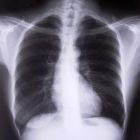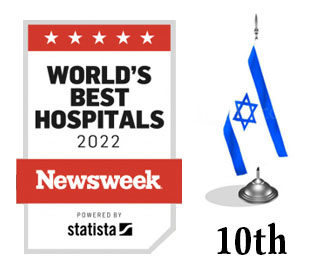Lung Cancer

Lung cancer is the leading cause of death among the men suffering from cancer, and is the third largest cause of death among women.
The average incidence of lung cancer is higher in men (approx. 55-60 cases per 100 000 population per year) than in women (40-45 cases). Lung cancer is currently responsible for 29% of cancer deaths in the United States, responsible for more deaths than breast cancer, colon cancer, and prostate cancer combined. In Israel, there are nearly one and a half thousand new cases of lung cancer annually.
In recent years, the incidence of lung cancer is growing rapidly and steadily.
World statistics on claims 1,300,000 thousand deaths per year caused by lung cancer. In most cases, lung cancer is diagnosed at a late stage of the disease and only 15% of the patients cured. For this reason, it is important to pay attention to changes in the body, which will certainly help to win time and healthy years of life.
Symptoms of the lung cancer is directly dependent on the location of the tumor and they could be seen a dry cough, which, with the time (progression of the tumor), can turn into moist cough accompanied by a discharge of mucopurulent sputum, sometimes streaked with blood, resembling a raspberry jelly. When a tumor begins to significantly impede the air flow through bronchi, there is shortness of breath. Chest pain usually occurs in the late stages of the cancer and is caused by the pressure of the tumor on surrounding organs.
The main symptoms of the disease include:
- coughing,
- shortness of breath,
- chest pain, coughing up blood,
- weight loss.
Detection of most of these signs should alert everyone and get immediate medical attention. It should be noted, however, that these symptoms are nonspecific, i.e., they are typical for other respiratory diseases. Therefore, unfortunately, many patients do not paying attention to these symptoms and do not seek timely attention of the professionals.
The main risk factor for lung cancer is active smoking. Out of the 100 cases of lung cancer, 70-75 of them are the consequence of active smoking. Passive smoking increases the risk of disease also. There is well established correlation between development of the disease and number of years and cigarettes that person has been smoking. For example, forty years of smoking increases the risk of lung cancer by half, compared with thirty years of smoking. The risk increases two times, if the habit of smoking has developed in the age of 15 years.
Lung cancer. Histological classification.(The histological classification of the lung cancer is based on the study of pathology of the affected tissue)
- Non-small cell lung cancer (NSCLC) represents 85% -95% of the total number of lung cancer.
- Small cell lung cancer (SCLC) represents 7% - 15% of the total number of lung cancer.
Classification of lung cancer in stages:
- Stage 0: accumulation of atypical (malignant) cells is detected.
- Stage I: a tumor mass size of 30 mm is localized, but lymph nodes are not affected and metastases have been not identified
- Stage II: a tumor may be small (3 cm) in size, but regional lymph nodes are affected by metastases; tumors larger than 3 cm
- Stage III: a tumor of any size with spread to the pleura and adjacent organs: esophagus, spine, blood vessels, heart, and with extensive metastases to regional lymph nodes.
- Stage IV: Tumor of any size with the presence of distant metastases.
Stages of diagnosis of lung cancer

The X-ray is a procedure that might reveal some pathological signs of the disease. Computed tomography and PET are providing the highest level of visualization of different tumors and therefore they are used for conformation and early diagnosis of lung cancer. The following test are performed, biopsy, bronchoscopy and mediastinoscopy , to determine type of malignant disease.
As an alternative to visual examination methods, testing for molecular biomarkers are performed as well.
Early diagnosis of lung cancer should applied to the young members of the smoking population, who exhibit lung cancer symptoms, as well as those, who are over 60 years old.
The main methods of treatment.
Chemo - and radiation therapy are used to treat the early stages of disease. Metastatic lung cancer is treated with the chemotherapy, using such drugs as Carboplatin and Cisplatin in combination with the latest generation of drugs Gamsitabin, Teksol, Teksoter and Nevalbin. The drugs are administered intravenously or orally in accordance with the established international protocols. In recent years, the prognosis of lung cancer has improved significantly due to a newly developed biological therapy methodology, as well as, treatment with antibodies.
Surgery is performed if the type of cancer diagnosed as NSCLC, a non-small cell lung cancer, with limited localization and which is not spread across the nearby organs. Depending on the size of the tumor, one or two lung lobes, or even the whole lung, could be surgically removed.
Post-op, additional treatment with chemotherapy is applied to the patients, who were diagnosed with SCLC. Radiation therapy is used on the growth stage of the disease only.
Dr. On Amir - The Head of the Lung Cancer DepartmentSpecialization: therapy, invasive therapy of the lung cancer. |
 |
Dr. Roni Weizen Head of the Department for the treatment of sarcomas.Specialization: clinical oncology, radiotherapy, malignant diseases of bone digestive system, breast, prostate and kidney. |
Clinical studies of lung cancer
The Department of Lung Cancer Treatment is performing numerous clinical studies on the drug to treat lung cancer in the I, II and III stages.
Department also investigates the cellular and molecular mechanisms that affect the normal lung tissue, causing damage and its subsequent transformation into a cancerous tissue. The study is directed to test the relationship between apoptotic processes and mechanisms which controls the cell destruction in the lung tissues.
The objective of this research is to develop a new biological model for prevention and treatment of lung cancer.




